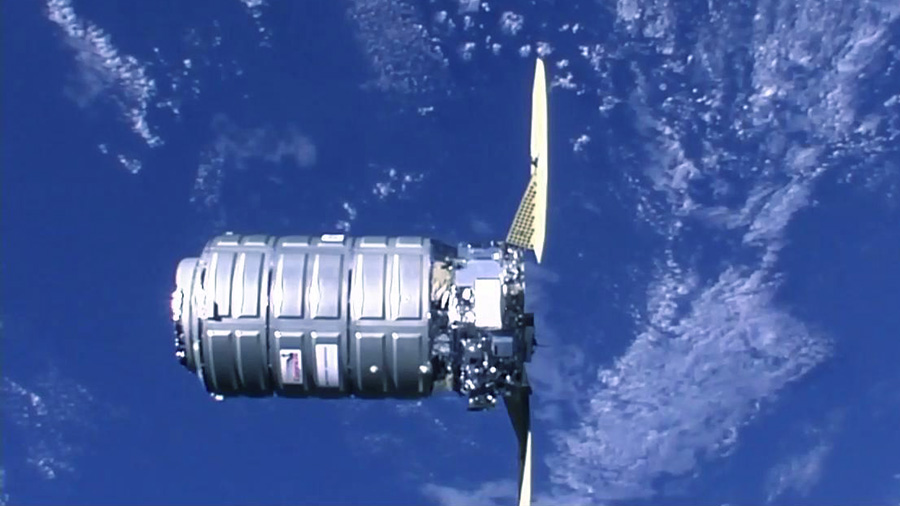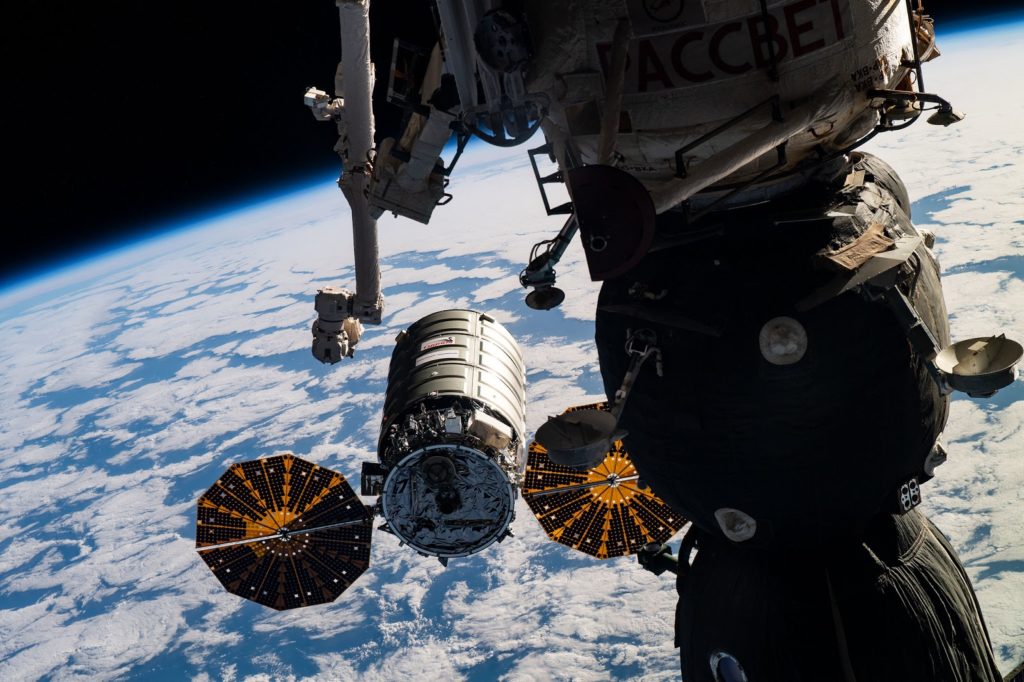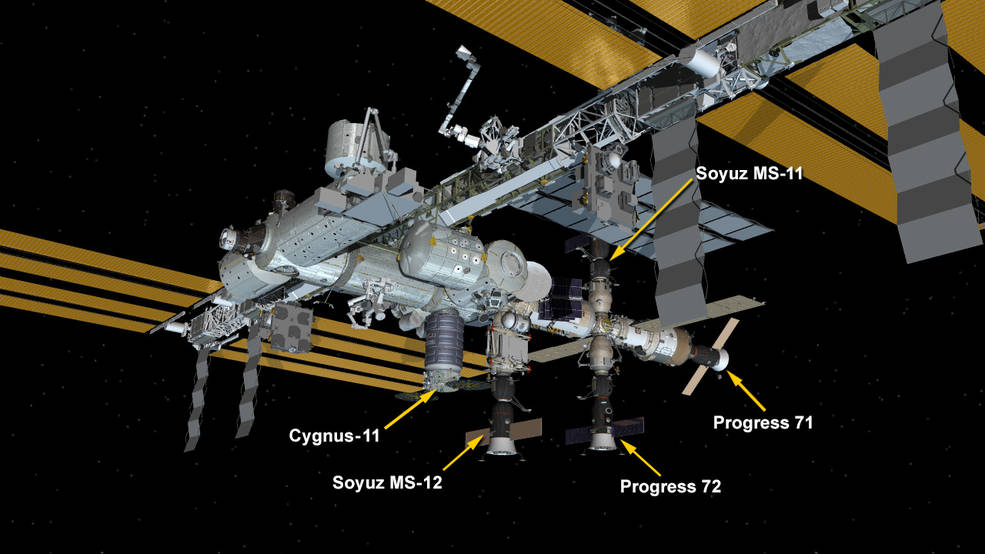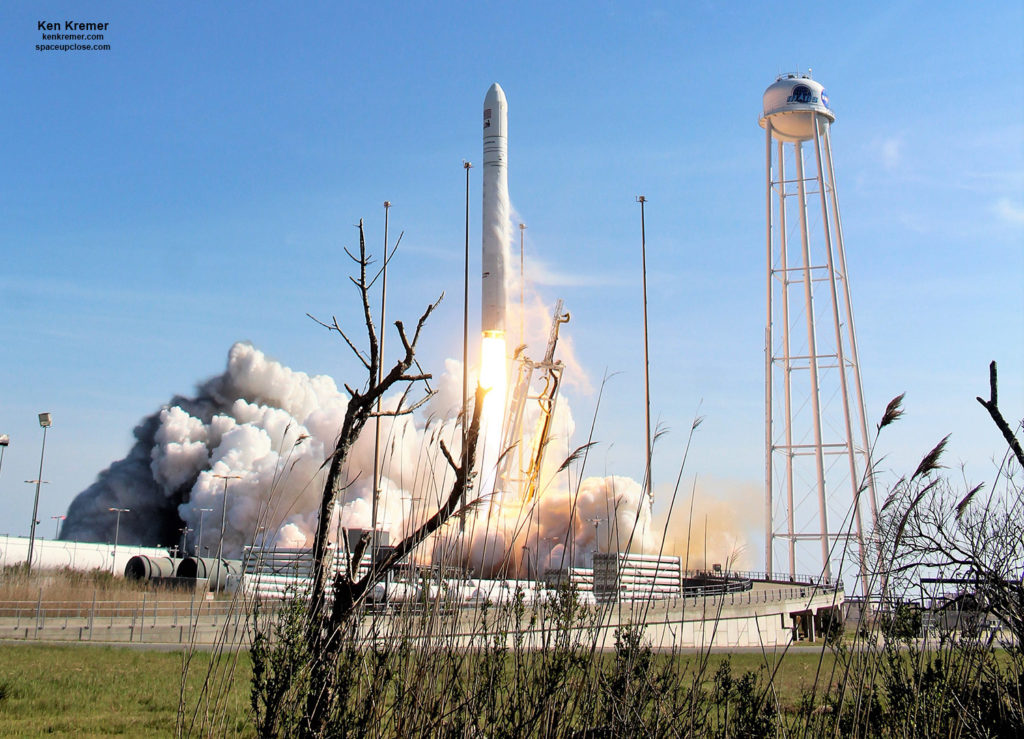Kremer — SpaceUpClose.com &
RocketSTEM – 21 April 2019
NASA WALLOPS FLIGHT FACILITY, VA – A day and a half after a beautiful afternoonblastoff from Virginia’s Eastern shore, the Northrop Grumman Cygnus commercial cargo
freighter arrived as planned at the International Space Station (ISS) Friday
morning, April 19, successfully delivering nearly 4 tons of new science and
supplies to the six person multinational crew.
After a carefully choreographed series of
thruster firings sending to to the vicinity of the space station, the Cygnus
NG-11 vessel was grappled at 5:28 a.m. EDT April 19 by Expedition 59 Flight Engineer Anne McClain of NASA using the stations Canadian-built robotic Canadarm2 while working at a robotic work
station in the 7 windowed domed Cupola module.
Canadian Space Agency flight engineer David
Saint-Jacques assisted McClain by monitoring Cygnus systems during its
approach. NASA’s Nick Hague
monitored telemetry during the crafts approach.
The station was flying over northeast France
at an altitude of 254 miles when it was captured.
 |
|
The Cygnus NG-11 spacecraft
from Northrop Grumman approaches the International Space Station for a robotic capture on 19 April 2019. Credit: NASA |
Ground controllers then took over to complete
the berthing operation and maneuver Cygnus into place on the orbiting outposts Earth-facing
bottom port of the Unity module at 7:31 a.m.
At the time of installation, Cygnus dubbed
the S.S. Roger Chaffee, was flying 255 miles above the Indian Ocean just
south of Singapore.
“Our arrival at the space station as the ‘S.S.
Roger Chaffee’ marks a proud moment for the NASA and Northrop Grumman teams,”
said Frank DeMauro, vice president and general manager, space systems, Northrop
Grumman.
“As we deliver critical supplies and cargo to
the astronauts aboard the space station, we are inspired by Lt. Commander
Chaffee’s courage and commitment to the human exploration of space. The Cygnus
spacecraft represents his planned journey to space in memory of those who took
great risks to advance our nation’s space program.”
Northrop Grumman Antares rocket from NASA Wallops launch base on the Virginia
shore carrying 40 micetronauts, a robotic astronaut helper, 63 thinsat free
flying experiments from over 250 students and a wide array of research.
The biggest crowd ever gathered
for an Antares launch witnessed the flawless performance put on by NASA’s
commercial cargo partner Northrop Grumman
as the rocket soared in its upgraded 230 configuration at 4:46 p.m. EDT (2046 GMT) Wednesday, April 17 from seaside Launch Pad 0A
at the Virginia Space Mid-Atlantic Regional Spaceport
(MARS) at NASA’s Wallops Flight Facility in Virginia.
begun unloading the cargo as they also prepare for the arrival of the next cargo
ship- the Dragon CRS-17 vessel to be launched by SpaceX on April 30.
pounds of research and supplies to space station.
Here is a NASA description of some NASA-sponsored
research to advance exploration goals and enable future missions to the Moon
and Mars include:
Models for growing increasingly complex
materials
Advanced Colloids Experiment-Temperature-10 (ACE-T-10) will test gels in a microgravity
environment. This research could aid in the development of increasingly complex
materials that may serve as the building blocks for a range of applications on
Earth including foods, drugs, and electronic devices. The process also may
provide an efficient method to build new materials and equipment in space.
for health and life sciences research, the equipment available for cellular and
molecular biology still is limited compared to capabilities found in
laboratories on Earth. To address this limitation, CSA designed Bio-Analyzer, a new tool the size of a video
game console that astronauts on station easily can use to test body fluids such
as blood, saliva, and urine, with just a few drops. It returns key analyses,
such as blood cell counts, in just two to three hours, eliminating the need to
freeze and store samples.
blood samples, oral glucose tolerance tests, and wearable sensors to study
aging-like changes that occur in many astronauts during their stay on the space
station. It’s one of three Canadian experiments exploring the effects of
weightlessness on the blood vessels and heart, and the links between these
effects and bone health, blood biomarkers, insulin resistance, and radiation
exposure. Increased understanding of these mechanisms can be used to address
vascular aging in both astronauts and the aging Earth population.
influence on an astronaut’s immune response, but there is little research on
its effect following an actual challenge to the body’s immune system. The
rodent immune system closely parallels that of humans, and Rodent Research-12: Tetanus Antibody Response
by B cells in Space (TARBIS) will examine the effects of spaceflight on the
function of antibody production and immune memory. This investigation aims to
advance the development of measures to counter these effects and help maintain
crew health during future long-duration space missions. On Earth, it could
advance research to improve the effectiveness of vaccines and therapies for
treating diseases and cancers.
aboard the space station. Building on the success of SPHERES, NASA will test Astrobee, a robotic system comprised of three
cube-shaped robots and a docking station for recharging; the first two are
aboard Cygnus. The free-flying robots use electric fans for propulsion and
cameras and sensors help them navigate their surroundings. The robots also have
an arm to grasp station handrails or grab and hold items. Astrobee can operate
in automated mode or under remote control from the ground as it assists with
routine chores on station, and requires no supervision from the crew. This has
the potential to free up astronauts to conduct more research.
the space station for about 3 months until July 23, 2019, when it will depart
the station, deploy NanoRacks customer CubeSats, and then have an extended
mission until December 2019 before it will dispose of several tons of trash
during a fiery reentry into Earth’s atmosphere.
Grumman’s CRS-1 contract with NASA before starting the CRS-2 contract missions
in the fall of 2019. Under Northrop Grumman’s Commercial
Resupply Services contract, the company will fly 11 missions.
onsite coverage of NASA, SpaceX, ULA, Boeing, Lockheed Martin, Northrop Grumman
and more space and mission reports direct from the Kennedy Space Center, Cape
Canaveral Air Force Station, Florida and Wallops Flight Facility, Virginia.
Planetary science and human spaceflight news: www.kenkremer.com –www.spaceupclose.com – twitter @ken_kremer
– email: ken at kenkremer.com
KSC area, active in outreach and interviewed regularly on TV and radio about
space topics.
Ken’s photos are for sale and he is available for lectures and outreach events
Falcon 9/CRS-17 launch to ISS, Falcon 9 Beresheet launch, USAF GPS 3-01, NASA missions, ULA Atlas &
Delta launches, SpySats and more at Ken’s upcoming outreach events at Quality Inn Kennedy Space Center, Titusville,
FL, evenings:
Apr
28-30: “SpaceX Falcon 9 Demo-1
and Beresheet
launch, Dragon CRS-17 resupply
launch to ISS, SpaceX Falcon Heavy & Falcon 9 launches, upcoming SpaceX
Falcon 9 ULA, NRO & USAF Spysats, SLS, Orion, Boeing and SpaceX Commercial
crew capsules, OSIRIS-Rex, Juno at Jupiter, InSight Mars lander, Curiosity and
Opportunity explore Mars, NH at Pluto, Ultima Thule, Kuiper Belt and more,”
Kennedy Space Center Quality Inn, Titusville, FL, evenings. Photos for sale





Hello Ken,
A good article again! I like your blog!
Greetings, Tamara